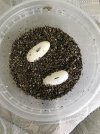Hi! So 19 days ago, my female leopard gecko was ovulating. I put her in with a male and saw them mate so I know it happened and everything.
I made my own incubator out of a styrofoam cooler, flexwatt, water bottles (to act as thermal masses), egg crate (to rest the egg boxes on), CPU fan (to prevent hotspots by moving air around), plexiglass (for a window), and a cheap Inkbird thermostat. I'm calibrating the incubator right now for 89* F to produce males.
I just had a couple questions... First, when the female has eggs developing inside her, do they both grow at the same time or is it more one and then the other? Lenetta definately has at least one egg which is getting pretty big, but there is a smaller round mass the size of an ovulation but whiter. Is that another egg or is it uncommon for the eggs to develop at different times?
Also, can someone please post pictures of gravid geckos at different stages of egg-development? I'd like to see what it normally looks like.
Last, how long after copulation will leopards lay? I though it was 16-22 days, but a friend of mine (he breeds ball pyhons and rodents, but his leopards "accidentally" laid eggs. He never got them to hatch, but still... he got further than I have!) said it can take up to a month??? He didn't know when his geckos mated so he doesn't know how long it was for him. Also a website I saw said it can take 2-5 weeks? I'm confused!
Thank you!
I made my own incubator out of a styrofoam cooler, flexwatt, water bottles (to act as thermal masses), egg crate (to rest the egg boxes on), CPU fan (to prevent hotspots by moving air around), plexiglass (for a window), and a cheap Inkbird thermostat. I'm calibrating the incubator right now for 89* F to produce males.
I just had a couple questions... First, when the female has eggs developing inside her, do they both grow at the same time or is it more one and then the other? Lenetta definately has at least one egg which is getting pretty big, but there is a smaller round mass the size of an ovulation but whiter. Is that another egg or is it uncommon for the eggs to develop at different times?
Also, can someone please post pictures of gravid geckos at different stages of egg-development? I'd like to see what it normally looks like.
Last, how long after copulation will leopards lay? I though it was 16-22 days, but a friend of mine (he breeds ball pyhons and rodents, but his leopards "accidentally" laid eggs. He never got them to hatch, but still... he got further than I have!) said it can take up to a month??? He didn't know when his geckos mated so he doesn't know how long it was for him. Also a website I saw said it can take 2-5 weeks? I'm confused!
Thank you!




